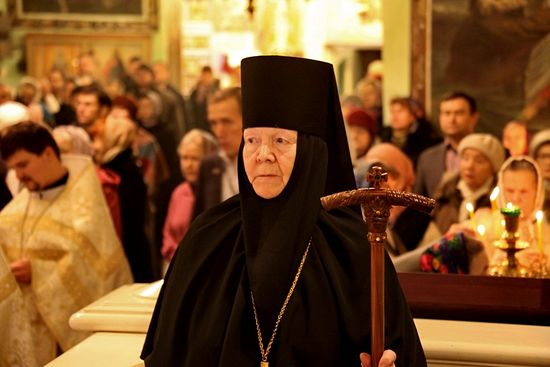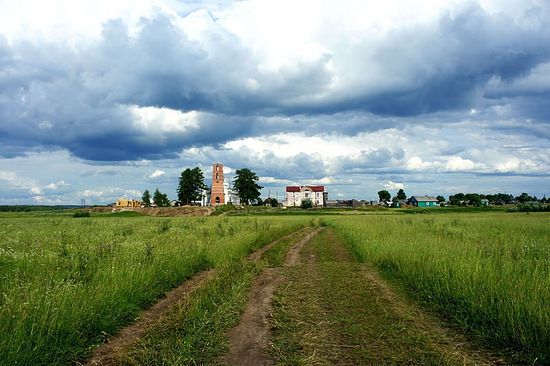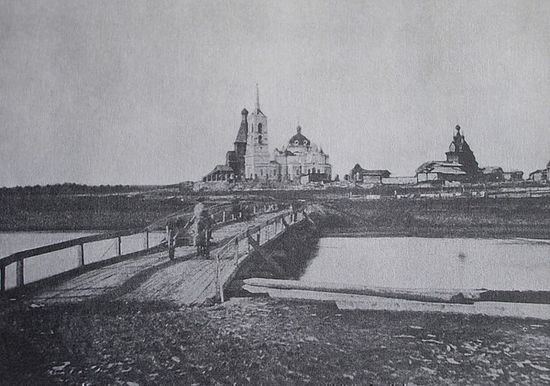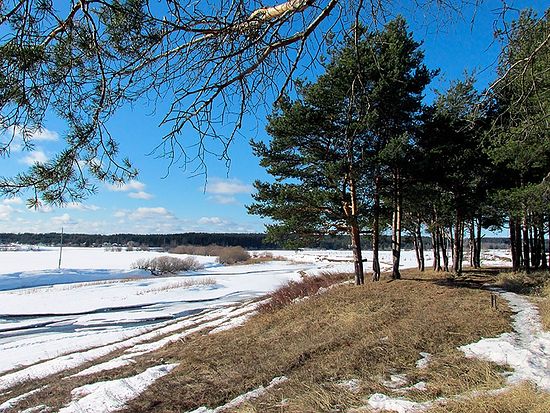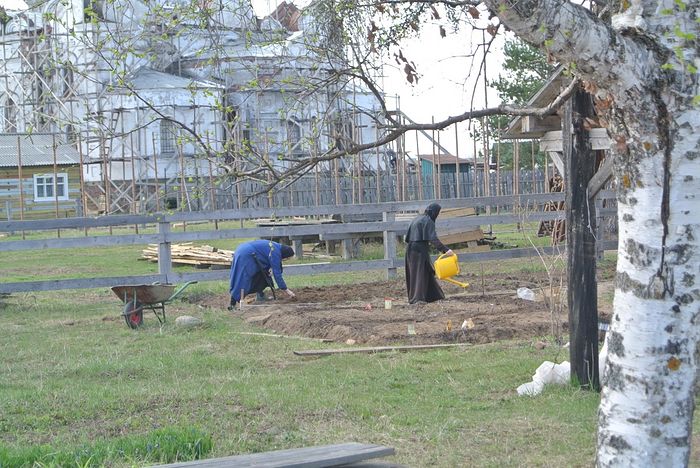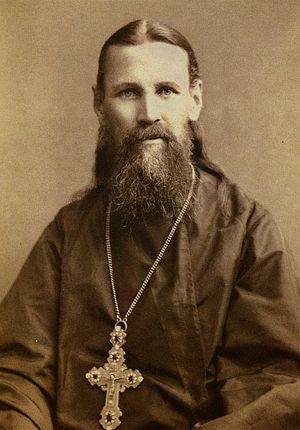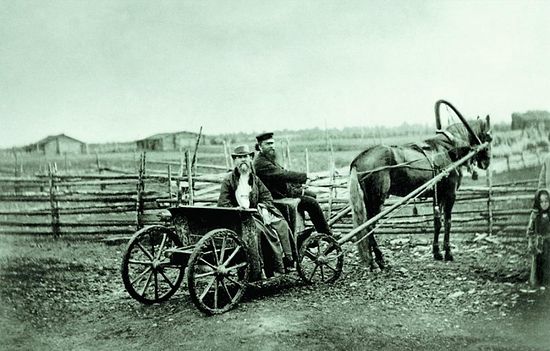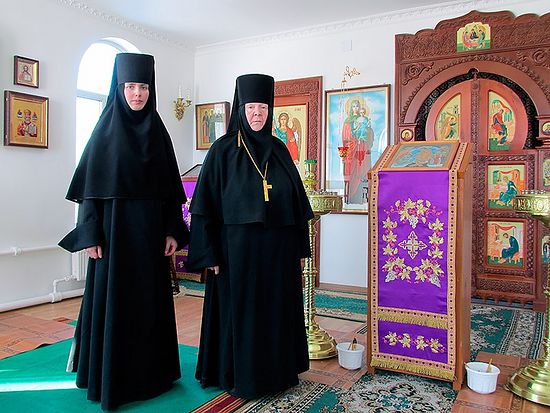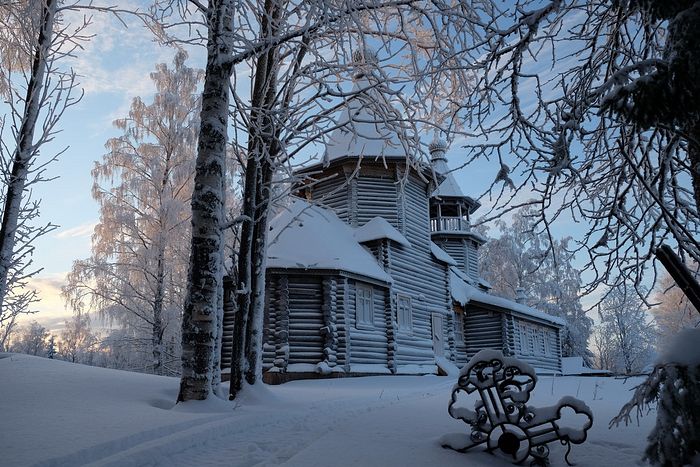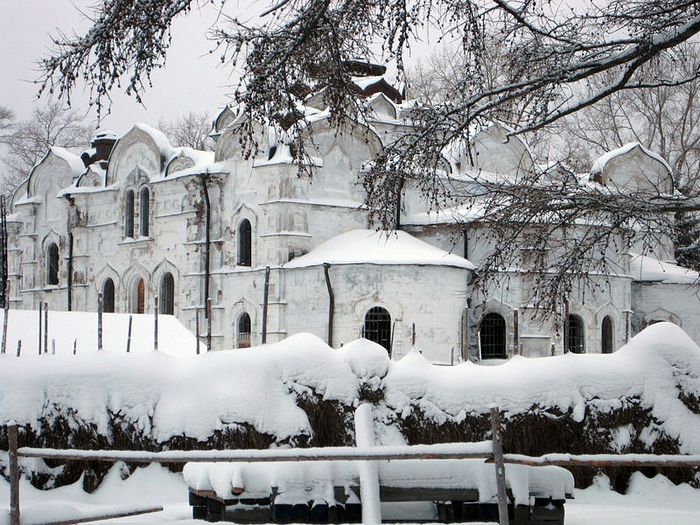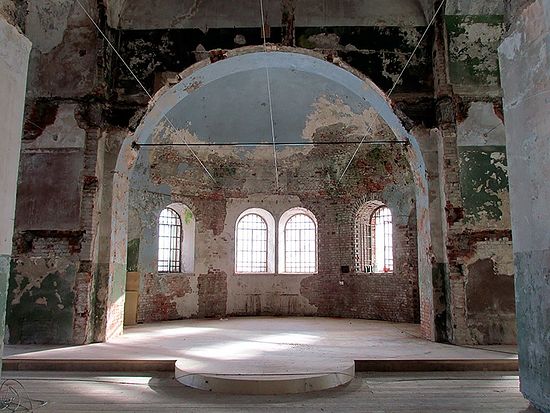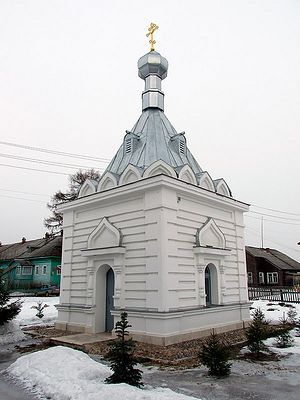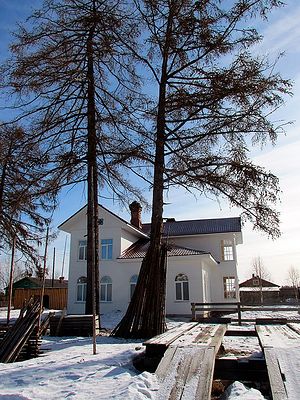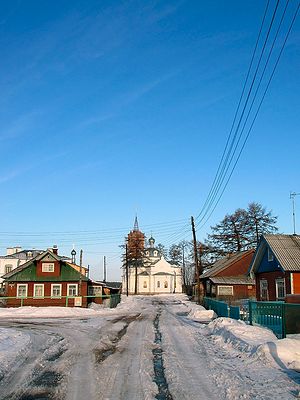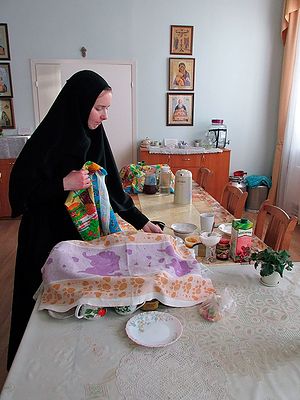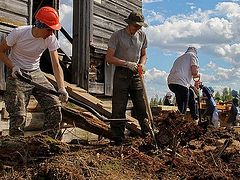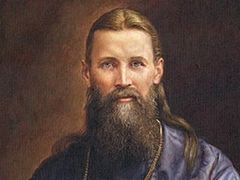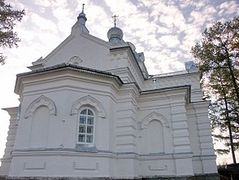Matushka Mitrophania categorically refused to go by car from the church to the monastery. “I really like to take walks after the Vigil. Nevermind that I’m 75 years old, that it’s cold and that the monastery is a kilometer away. I like to look at the starry skies of Sura. Let’s go together—we’ll talk at the same time.”
A short walk under the clear, northern sky… The stars seem so close that you could catch them with your hands. Or you could simply watch, contemplate, admire and drink in this might of the Russian North—contemplate, and praise. Matushka Mitrophania recalls the words of her favorite saint, Holy Righteous John of Kronstadt: “The soul is involuntarily aroused to give praise when you look at the starry sky; but it is even more aroused to praise when, looking at the heavens and stars that God established, you imagine God’s providence for people, how God infinitely loves people, cares for their eternal blessedness, without sparing even His Only-Begotten Son for our salvation and peaceful habitation in the Kingdom of Heaven. You cannot but praise God when you recall that we are created from nothing, that we are foreordained from the foundation of the world for eternal blessedness absolutely unearned, gratis, not for our merits; when you recall what grace God grants to you for salvation throughout your life, what a numberless multitude of sins are forgiven you, not once, not twice, but countless times, what a multitude of natural gifts you are given, beginning with the health of your body to the streams of air, to the drops of water. The soul is involuntarily aroused to give praise when you see to your amazement the endless diversity of creation on earth—in the animal kingdom, the plant and mineral kingdoms. What wisdom there is in all of this creation—in the great and the small! You cannot help but give praise, and say, “Wondrous are They works, O Lord, in wisdom hast Thou made them all; glory to Thee, O Lord, Who hast made them all.”
This recollection alone, pronounced in the abbess’s quiet voice, believe me, made it worth it to traverse the hundreds of versts it took to get here. And when it is accompanied by the a real-life affirmation of that wondrous beauty, that as if meek but invincible power of northern nature—modest, insistent, daily presenting itself as “didactic material” in lessons of piety, you then pay no attention to fatigue, you begin to look with wide-open eyes and listen attentively to the instructor walking alongside you.
Matushka Mitrophania leans on the arm of Sister Nina—her faithful assistant; they walk along the broken road unhurriedly, and we talk. The abbess’s scholarly St. Petersburg pronunciation sounds perhaps a little unexpected in these latitudes, but all the more dignified and accessible for them. She talks about what she felt when she heard that she was being offered to leave the St. John Convent in St. Petersburg for faraway Sura, in the extreme north.
—It was three years ago, in 2012 [this interview was published in Russian in 2015.—Trans.]. The Holy Synod resolved to open the Sura Convent, and I was appointed its abbess. They asked me if I would go to Sura, in Archangelsk Province, in the far north. I replied, “I won’t just go there—I’ll walk there!” And I’ll admit that throughout the whole time I’ve been here, never once—not one hour, not one minute—have I regretted that I ended up here. And it’s not just a matter of the beauty of northern nature, of course. I think that regardless of our community’s poverty, its material insufficiency in comparison with other monasteries, it is much more meaningful that all the sisters who live here came to Sura at the call of their hearts. There are only six of us—five sisters, and me, the abbess.
—Matushka, you say that the St. John Monastery is not wealthy and not large, that only six people pray and work here. How do you manage all the many difficulties?
—First of all, one has to know that people don’t join monasteries “out of something”—out of depression, or failures in personal or family life. People go to monasteries to something, or more precisely, to Someone—to Christ, and His saints. I have already said that our sisters came here at their hearts’ call, out of love for God and His saint—Righteous John of Kronstadt. If a person does not have such qualities, then the very conditions of life in Sura will help her more quickly and honestly look into her own heart, and see whether she will be able to endure here for very long. And if there is love and hope in the help of Christ and St. John in her heart, then believe me, she will accept any hardships tranquilly. How many times have we been convinced that Batiushka does not leave his sisters without grace-filled help! This happens almost every day; such “ordinary miracles” are innumerable. And we are convinced through our own experience that God does not deprive us of His help, and that St. John of Kronstadt is always near us.
—Tell us please about the convent’s past.
—The Sura Convent was the child of the Pastor of All Russia, as they call St. John of Kronstadt.[1] Batiushka found no few means for its construction, participated in the establishment of its monastic rule, sent sisters here, and instructed the first novices.
In the beginning of the twentieth century, the St. John Convent did charity work; it gave much aid to the needy and suffering, supported the relatives of those who died in the war, gathered money for charitable causes, and also gave alms.
Neither did they neglect education—the monastery had a reading room from which parishioners could borrow Orthodox magazines and newspapers, and there were various workshops. In general, the monastery was a center of enlightenment in Sura and the surrounding areas (here these areas are called the Sura cluster)—there was a parish school for children and a Sunday school for adults, where people were taught not only prayers, but also literacy in general, as well as trades: sewing, handiwork, knitting, and repairing clothes. There was even a pharmacy and hospital for the peasants!
The monastery was large—in 1915 there were nearly 200 sisters. It seems to me that we can imagine life in the St. John Convent before the revolutionary upheavals in Russia from a short excerpt from the book by Sergei Zhivotovsky, In the North With Fr. John, published in 1903:
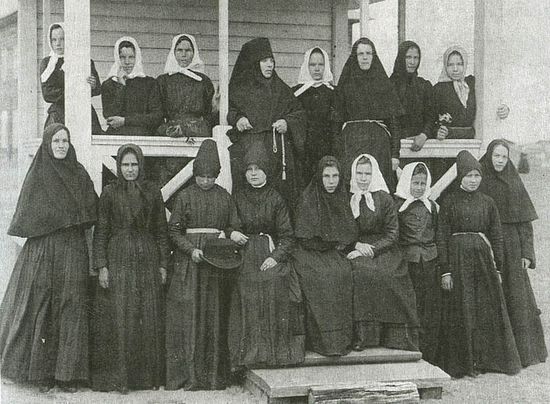 Sisters of the St. John the Theologian-Sura Convent. Photograph from the early 20th c.
Sisters of the St. John the Theologian-Sura Convent. Photograph from the early 20th c. “This is my natural sister, and this is my nephew,” Fr. John told me, pointing at my neighbor and the neighbor of Fr. George. The neighbor of Fr. George turned out to be the son of my neighbor. In a further corner of the room were two more nephews of Fr. John—the youngest children of his sister, also in peasant dress and behaving themselves with the utmost modesty. The two older nephews are married and work in the grain field with their families.
“Here could be clearly seen Fr. John’s unselfishness. Another in his place would have benefitted all his relatives, giving them the opportunity to live easily and richly. But to Fr. John all people are equally close, and he does not give his relatives any advantage, helping them, but not any more than he does others. And his relatives do not complain about this, because they have long been accustomed to seeing him as a very special person who is not of this world.
“Here I learned that in his childhood, the son of psalm-reader Ilya Sergeyev, the little, thoughtful Ivanushka, enjoyed the particular respect of his fellow villagers. A peasant is selling his horse—he goes to Ivanushka to ask his prayers; grief or illness befalls someone—again they go to Ivanushka.
“So, the wondrous boy grew up, and his glory shone over Orthodox Rus’ like the sun. And in the wild, austere hermitage, amidst the thick forests and loose sands, where there has never been anything more than a dozen peasant huts and a half-ruined wooden church, the white walls of a magnificent stone church with its golden crosses shone over a young monastery that was growing by the hour.
“All of literate Russia knew the town of Kholmogory in the Russian North—the native land of the great Russian scientist Lomonosov. Now all Orthodox Russia will know Sura—the homeland of its honored pastor. Only four years ago, Fr. John placed the beginning of the Sura Convent. And now there are already 120 sisters, the majority of whom came here to this severe, wild locale from the furthest corners of Russia. Only an insignificant percentage of them are from Archangelsk province.”
Here I could add, for example, the following. Mikhail Vasilievich Lomonosov, our great scholar and scientist, having left Kholmogory for the capital city, never returned to his homeland. Perhaps he simply didn’t have the time. But Batiushka John, to the contrary, took advantage of every opportunity to visit his “dear motherland, sacred homeland, blessed Sura,” as he himself would say.
—Let’s talk about the times about which Fr. John warned his contemporaries, with worry and pain for his Motherland, both the lesser and the greater—all of Russia. Several years after his death came our national catastrophe, which was caused, in his words, by the apostasy from God by a large part of our people…
—Yes, Batiushka would say that because of Russia’s apostasy it will even lose its name! During those long and terrible decades, we lived namelessly, having lost our own country. We won’t talk now on the scale of all of Russia—let’s just take a look at Sura and the surrounding areas. The scale of godless destruction was terrifying. The destroyed churches in the Russian North, the closed and desecrated St. John Monastery, the ban on even calling ourselves Orthodox Christians, persecutions, tortures, harassment of Christians—our land went through all of this. Attempts to force the Russian people to abandon their faith, I think, also had a lasting influence on their changed mentality, which has led to grievous changes in our material life. Where now is the Russian village with its sturdy, well-made household, its robust inhabitants, always ready to come to another’s aid in a difficult moment? I have noticed that the village where a church was destroyed inevitably dies out if it does not labor to restore its church. I remember after the war, having regained my strength after the blockade [the WWII German blockade of Leningrad, in which millions died of hunger and disease.—Trans.] (I am a blockade survivor, I lived my early years in Petersburg, and that was right during the war), I ended up in Vologda province, Vytegra region. There was a huge village there, and in the desecrated churches was either a “house of culture” or club, I can’t remember which. Then, thirty years later, I went back there—out of that large village there were only four houses left at most. Three old ladies were living amidst the black skeletons of peasant huts jutting out of the snow. Oh, how painful it was to see it! And that is how it is everywhere, all over Russia—wherever they don’t restore the church, the village dies. If there is a church, there will be life. The houses will stand sturdy, people will find work, and they’ll have a robust domestic life.
—Can you cite examples of such renewal?
—Well, there is Sura, for example. After many long years of desolation, at the prayers of Batiushka John, good people came from various corners of Russia who began to labor for the creation of a sisterhood in this village; they formed a parish, and out of the ruins began to renew the St. Nicholas Church and Skete. A little later, the parishioners of the St. John of Rila Monastery in St. Petersburg, with the help of benefactors, continued their labor, and conditions were created that made it possible to rebuild the convent in Sura. To the credit of the inhabitants of Sura, the majority of them responded joyfully to the restoration of the monastery. Now that large-scale work is needed—construction, interior work, household fixtures, etc.—many local people help us in this. And in helping the monastery, people, especially the young folks, begin to gradually come closer to God, through the prayers of their holy townsman. This is very important for Russia, for a Russian cannot live without God.
Sometimes the workers meet up directly with Batiushka’s instructions. So that it would be more understandable, I will cite an example. We drilled a well. This is, incidentally, not so easy—one has to dig at least eight meters here to reach water. So, the foreman insists on drilling in the place where he wants to dig, saying it’s more convenient there. I told him, “Don’t drill here. According to my information, there was, forgive me, a toilet here for a long period of time.” “What difference does it make! It will be faster here and cheaper, and I have a budget to keep,” and so on. “Please, don’t do it!” I begged. Well, he didn’t listen to me. I prayed, “Dear Batiushka, help make this man understand!” Twenty minutes didn’t go by before the foreman was running back to me. “The drill broke! We dug ten meters—no water; we drilled deeper, and the drill broke in half! Forgive me, Matushka!” Thus do we live, coming closer to Christ; here the drill breaks, there miracles happen. If only people would come to Christ—and Fr. John always helps in this.
—Judging from your peaceful disposition and sureness of God’s help, you don’t get despondent when you encounter difficulties?
—Can a monk or nun despond?! Forgive me, there is simply no time for that. There is no time to even get sufficiently sick—too much to do, and for despondency there is not time at all. Too much to do.
—Well many consider that monastic life is an escape from work and problems. You just pray all the time…
—“You just” get up at four in the morning, go to bed after midnight, work in the cattle barn (we have three cows and other animals), help in the building work, work in the kitchen, in the laundry room, clean the walkways, chop wood, don’t forget about the perpetual Psalter reading, go to all the Church services, and pray all the time—and sincerely, from the heart at that…
—A great escape!
—I repeat, people come to the monastery who love to pray and labor—those who have the love of Christ and of our dear Batiushka in their hearts.
But, of course, in a monastery that was only recently reopened there are now a lot of difficulties in establishing the spiritual and material life. However, difficulties are not an excuse for complaints, but a reason to work, right?
—Does the monastery have any plans? After all, earlier, apart from everything else, the monastery conducted great enlightenment and social work.
—Yes, the Sura Convent plans to revive its charitable work. We hope to create a home for female orphans, an almshouse for the elderly who have no family, a Sunday school, and also to help the village to revive its various trades and crafts, the traditional folk trades. This is being aided by the preparations for the coming twenty-five-year anniversary of St. John’s canonization by the Russian Orthodox Church[2]…
—Returning to the theme of the connection between the building of churches and the renewal of the Russian village. Sura is a large village, with over 2,000 inhabitants. How many churches are there in the village?
—For now, we hold most of the services in the church dedicated to Holy Righteous John of Kronstadt. The church is on the first floor in the house of priest George Maddaveyev, a friend and colleague in prayer of Fr. John. While still a deacon, George Makkaveyev was, with Batiushka’s blessing, the organizer of the construction of church buildings. When the saint came to Sura, he would stay in the Makkaveyev house, on the second floor, which had a window that overlooked the monastery. In 1902, Fr. George was ordained a priest. He suffered during the persecutions in 1920.
Besides this church in Sura there are two cathedrals. The St. Nicholas Cathedral was opened for parishioners in 2013. In autumn of 2014 the construction work on the church’s bell tower was completed. The Dormition Cathedral began to be restored only recently, but the work has gone on very actively—the floors have been laid, the roof repaired, and now they are restoring the central cupola and gilding the cross. I remind you that local workers are doing this. Thus, we have three churches in our village.
—What do you think—will they be filled with worshippers?
—During the celebrations, of course they will be. The rest of the time, I think that we will be serving in the churches that can accommodate the necessary number of parishioners.
—There is no little work being done in preparation for the celebrations, and no less to do afterwards. Tell me, Matushka, how can we help your monastery?
—Our convent would be grateful for any help: building materials, tools, transportation, building equipment, food products, money, etc. Of course, we ask the prayers of all Orthodox Christians for our monastery. I would also like to say that in helping the convent that was founded by St. John of Kronstadt, one gains as fervent prayerful intercessor in the saint, who intercedes before the Lord. We pray and believe that sisters will come to the new convent—lovers of labor and women of prayer; that spiritual, monastic life would become well-established, that the household will be set up, that more pilgrims will come, and the dream of our dear Fr. John of a flourishing monastery for women in his earthly homeland will become a reality—that it will bring people from the earthly fatherland to the Heavenly Fatherland… Just look at the vast sky, how many stars, and how brightly they shine! Sometimes I am sure that Sura borders Heaven. Come to us more often. But now let’s go drink some tea—the sisters have prepared some zucchini jam. I assure you that you’ve never tried anything like it before.
Tea after a walk is a nice thing. But tea with zucchini jam and prayer, especially in Sura, in the monastery… The sky looked down knowingly, winking with its enormous stars. To be sure, it was smiling.
* * *
Abbess Mitrophania wrote recently on the monastery website that at the present time, much work has been done in the restoration of the churches: The St. Nicholas Church, bell tower, and St. Elias Chapel have been restored. The Skete has been rebuilt, and the church building housing a museum and house church dedicated to St. John of Kronstadt has been fully repaired. Two guesthouses have been built. Work has begun to restore the Dormition Cathedral, and a House of Mercy is being built for elderly, widowed priests.

